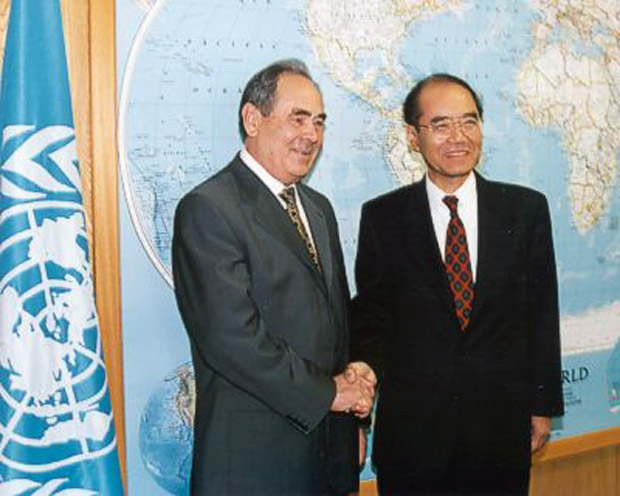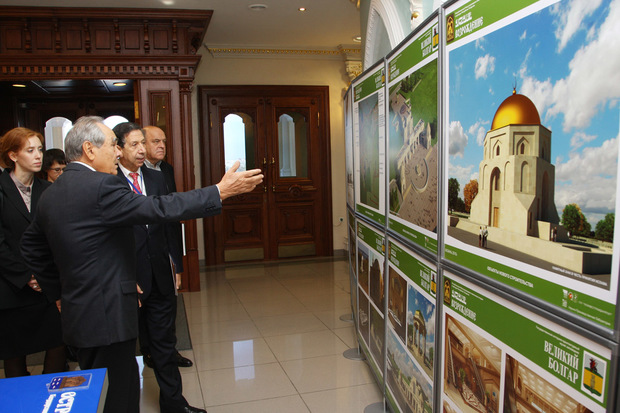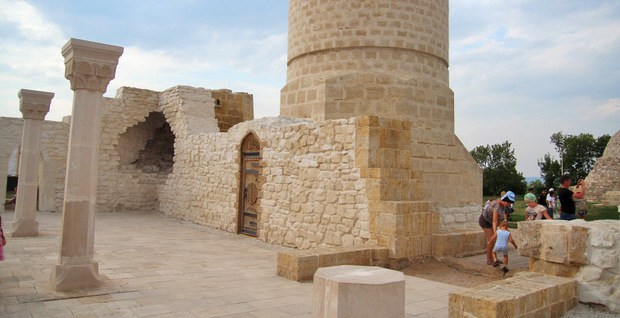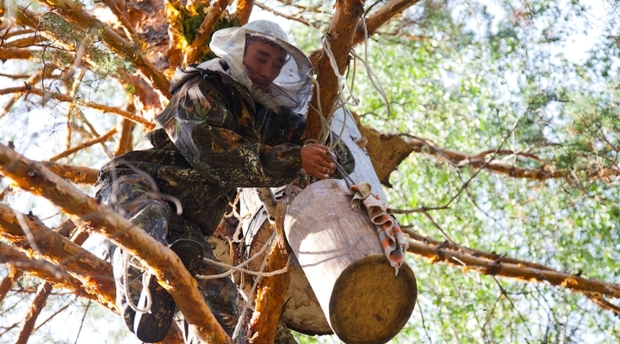Munir Bushenaki: ‘Main difficulty of Kazan Kremlin inclusion in UNESCO List was Kul Sharif Mosque’
The main friend of Tatarstan in UNESCO tells about Tatarstan delegation in Paris and Northern Orthodoxy
Munir Bushenaki, a functionary of UNESCO, has recently visited Kazan. The expert of the International Council on Monuments and Sites (ICOMOS) and the head of the Arab Regional Centre of World Heritage, who actively helped to include the Kazan Kremlin and Bolgar in the List of World Heritage Sites of UNESCO, is well known in Tatarstan. Mr. Bushenaki told the correspondent of Relanoe Vremya how he learnt about Tatarstan for the first time, thanks to Mintimer Shaimiev, and whether there are chances to recognize Sabantuy (a Bashkir, Idel-Uralian and Tatar summer festival) as an object of intangible heritage.
About how Mintimer Shaimiev acquainted UNESCO with Tatarstan
Mr. Bushenaki, do you remember your first meeting with Mintimer Shaimiev?
The day before, I was studying the photos and the documents on the inclusion of the Kazan Kremlin in the List of UNESCO. But Shaimiev made an unusual move. He brought to Paris the delegation of more than 100 people: there were beautiful young ladies dressed in national costumes, he acquainted us with the music, with the culture of Tatarstan, with national cuisine. So we learnt much more about the Republic.
That time, the Director General of UNESCO was Kōichirō Matsuura, he travelled a lot that time and he did not have the time to be there for long. He welcomed Mr. Shaimiev and delegated responsibilities to me to spend the remaining time with them. These hours, discussions that we had – they contributed to the close friendship.

That time, the Director General of UNESCO was Kōichirō Matsuura, he travelled a lot that time and he did not have the time to be there for long. He welcomed Mr. Shaimiev and delegated responsibilities to me
I knew that Tatarstan had already submitted the nomination dossier on the inclusion of the Kazan Kremlin in the List of World Heritage Sites of UNESCO. The fact that this dossier was also presented in Paris, gave us a deeper understanding of the value of the Kazan Kremlin. After the Kremlin was included in the World Heritage List, Director General asked me to come here and to present the official certificate. During the visit, I met many people: political leaders, the mayor and his deputy, other officials, religious figures, representing Christianity and Islam. These meetings gave me a deeper understanding of the value of this place. Also, since my wife accompanied me on this trip, she became the biggest fan of Tatarstan. Then we also visited Bolgar, even though it was not even nominated, it was just being prepared for this.
Then with such people, as Rafael [Valeyev, Professor of the Kazan State University of Culture and Art, Vice President of ICOMOS Committee of Russia – editor's note], with the specialists from the University we found out how valuable this historic and archeological place is. From that moment, I worked very closely with my colleagues here, particularly with Ms. Mitrofanova, who is an Ambassador for UNESCO in Russia. We have made every effort to make the World Heritage Committee of UNESCO understood why this place should be included in the World Heritage List. This activity was very useful not only for Tatarstan, but for the two UNESCO organizations that work to protect cultural and natural heritage. Because when you present an object to the Commission at UNESCO, you should justify the basic criteria in the best way. First of all, you should justify the outstanding universal value of this object. This is a very important kind of work because you need to explain that this object has a value not only for the local population or, say, for Russia, but it is very important for all mankind. The next very important criterion is the integrity of an object. There should be no roads that cut an object, there should be no new buildings that violate the integrity of perception of an object from a historical point of view. The third criterion is authenticity. What we find in this object must be in its original form. That's why I say that we made every effort in order Bolgar was included in the World Heritage List. And we did it.

We have made every effort to ensure the World Heritage Committee of UNESCO understood why this place should be included in the World Heritage List
During our cooperation, two years ago Shaimiev also brought me to the island town of Sviyazhsk, which was for me another discovery, because it has immense significance for the Russian Orthodoxy. During the discussions that we held with Shaimiev, Tatiana Larionova, and other invited University experts, we came to the conclusion that not only Bolgar, as the most northern point of the spread and adoption of Islam, but also Sviyazhsk, as the place from which began the dissemination of Russian Orthodoxy to the East, is of great value.
The potential pitfalls of the inclusion of the Kazan Kremlin in the List of UNESCO
At what stage is the process of inclusion of Sviyazhsk in the List of World Heritage and what is left to do?
I want to say that we have already advanced quite far. When you nominate an object for inclusion in the World Heritage List of UNESCO, you must provide a nomination dossier that contains not only a historical description of the object, but also the justification for why it needs to be included. And the purpose of the Commission, which lasts several days in August, is to make sure that everything presented in the dossier corresponds to reality. Once the dossier is given to UNESCO, it goes to the independent non-governmental organizations. If it is a cultural heritage, the file is sent to the ICOMOS for assessment, and if it is a natural heritage — to the International Union for Conservation of Nature. The organization consists of experts of scientific community. Now, these specialists have come here because they have to see it with their own eyes. In February-March next year, they will give recommendations to the World Heritage Committee of UNESCO on the inclusion or non-inclusion of Sviyazhsk in the List. Then at a sitting of the World Heritage Committee in Poland in July 2017, the inclusion will be considered.
What about the Kazan Kremlin, it would be interesting to know how was the process of inclusion in the World List going, what difficulties arose in the course of this?
When a dossier is submitted, it never happens that all components are observed at the highest level. Specifically, on the Kazan Kremlin the main difficulty was the fact that inside the object there was a modern building of the mosque Kul Sharif. Another aspect was the fact that not all the buildings that were inside the Kremlin were in a presentable condition, they could not be shown to the public. It was also one of the comments. But the most difficult question we had to solve is still the mosque, which was built. Nevertheless, the establishment of this mosque was a very important argument in favor of the fact that in the Kremlin two religions peacefully coexist.

Sabantuy and Bashkir honey as the objects of intangible heritage
Not so long ago you have been in Bashkortostan and there they discussed Bashkir honey to be an object of intangible heritage. I wonder, is there still a chance of Bashkir honey and, for example, Sabantuy to be recognized as the intangible heritage?
I was thinking about this too, when I arrived here for the first time. Mr. Shaimiev immediately took me to Sabantuy. It was somewhere in 2001 and I was working on the preparation of the new convention, which concerned the conservation of intangible heritage.
When we were invited to Ufa for the first time — it was about the two objects. They wanted to include the rock paintings in the List of World Heritage, and we worked there with ICOMOS experts on this issue. Besides, in Bashkiria, beekeeping is a highly developed, particularly, the harvesting of wild honey. They wanted to include it in the UNESCO List. After a two-day seminar, we recommended them to revise it in terms of management and presentation of the place, where was located the rock paintings. After returning, the report that I sent to the World Heritage Centre I also sent the President of Bashkiria. The thing is that the forest was just an added bonus while working on this cave. And this is exactly what I tried to offer them — the wild beekeeping included in the list of intangible heritage. This beekeeping meets all the provisions of the convention on intangible heritage because this involves real people, the tradition is maintained since time immemorial and they use the technique that needs to be documented and saved.

'This beekeeping meets all the provisions of the Convention on intangible heritage because this involves real people, the tradition is maintained since time immemorial.' Photo: sputnik-germes.ru
However, the problem is that Russia still has not ratified the 2003 Convention. I think it is no secret that several days ago we discussed the convention ratification issue by Russia with Mr. Shaimiev, with the Goodwill Ambassadors Aleksandra Ochirova and Grigory Ordzonikidze, who is a department officer of the Ministry of Foreign Affairs of Russia and represents the UNESCO Committee in Russia. There is the special convention ratification process by a country, but it also must be adopted by the Parliament or Legislative Assembly. When we started the convention, I already warned that not all the countries would agree. But soon it became popular and we have 160 counties that have ratified this convention. I hope Russia will also do that. I can help you with that, to work with you.
Reference
Munir Bushenaki (Arabic: منير بوشناقي) — an Algerian archaeologist and incumbent director of the Regional Center of the Arab World Heritage. In January 2011, Bushenaki was appointed as an honorary special adviser to the Director General of UNESCO Irina Bokova and Director General of ICCROM Stefano De Caro.